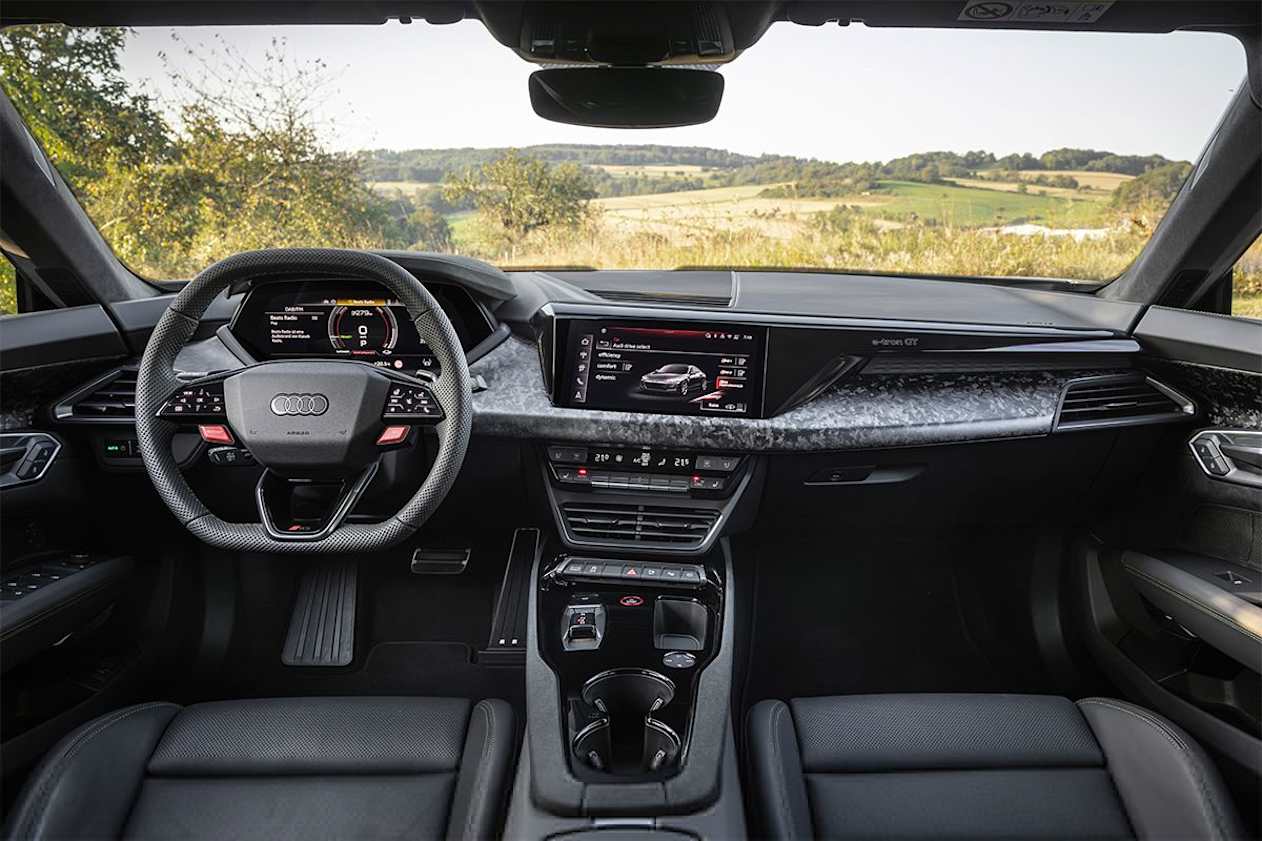After the lights went out on production of its awesome V10-powered R8 earlier this year, Audi’s other high-performance sports car - the sleek e-tron GT - took the mantle as Audi’s flagship model.
The big difference, of course, is that the e-tron is an electric vehicle and represents Audi’s future.
The brand has a storied history when it comes to performance models under its Audi Sport banner, and the e-tron was a welcome addition to that stable.
-
Electric car price slashed more than $3000 before release: 2025 Audi Q4 e-tron SUV arriving with sharper entry price to undercut BMW iX3 and Mercedes-Benz EQA
-
Opinion: Audi's got new confusing names for its cars, just as we were getting used to the old confusing names
-
Porsche loses lap record to Audi! 2025 Audi RS Q8 detailed after smashing Porsche Cayenne Turbo GT's Nürburgring time
For the 2025 model year, Audi has made some subtle, as well as some significant changes to the striking four-door EV.
Design tweaks, interior trim upgrades, more features, more power and faster charging are just some of the improvements.
We spent some quality time with the new e-tron GT in its German home market to see whether this update has improved the grand tourer.
Audi E-Tron Gt 2025: Quattro
| Engine Type | Not Applicable, 0.0L |
|---|---|
| Fuel Type | Electric |
| Fuel Efficiency | 0.0L/100km (combined) |
| Seating | 5 |
| Price From | $181,784 |
| Safety Rating |
|
Price and features – Does it represent good value for the price? What features does it come with?
8 / 10
Audi has not revealed pricing or Australian specification for the 2025 e-tron GT as it’s not set to arrive Down Under until some time in the first half of 2025.
However, pricing has crept up a little in Europe so expect the same here. For reference, current pricing starts at a tick over $181,000, before on-road costs, and climbs to $250,000.
Previously there were just two grades - the entry-level (if you can call it that) e-tron GT and the top-spec RS e-tron GT. Audi has increased the range from two to three grades.
The new entry point is called the S e-tron GT, followed by the RS e-tron GT, and now Audi is offering an RS e-tron GT ‘performance’ grade.

This is the first fully-electric Audi RS to get the ‘performance’ tag that’s found on other models like the RS6 Avant. The performance model is also the most powerful production Audi model ever made.
Audi Australia is believed to be considering all three grades for a local launch.

As mentioned, standard gear is yet to be confirmed but expect items like wireless phone charging, sports seats, electrically adjustable driver’s seat with memory function, a head-up display and more.
Design – Is there anything interesting about its design?
9 / 10
You could argue the e-tron GT was already a stunner and didn’t require any visual changes, but Audi has still made a few tweaks. Thankfully, they are relatively subtle.
The 2025 e-tron GT gains refreshed front-end styling with a new front grille, headlights and lower bumper and air intakes. The look is inspired by Audi’s latest design language as seen on the recently revealed A6 Avant e-tron.
The S has more subtle front and rear styling, while the RS and RS performance take on a more aggressive and sporty look with a dramatic rear diffuser and different lower front styling.

The RS performance further differentiates itself from the RS with an optional matt, darkened carbon roof and optional ‘carbon camouflage’ elements found in the embossed bumper, door trim, parts of the diffuser and side mirrors.
Audi has introduced some rather gorgeous new alloy wheel designs, some standard, some optional.
I had forgotten how stunning the e-tron is in the metal. You can see by its stance that it’s related to the Porsche Taycan - they share the 'J1' platform.

Despite the low-slung sports sedan vibe, they have their own distinct identities. If you’re after elegant clean design, you’ll likely favour the Porsche. But I am increasingly leaning towards the Audi on the design front.
Inside you get redesigned sports seats, a new steering wheel and fresh inlays, including sustainable wood on some grades. I love the new steering wheel, covered in Audi’s version of synthetic suede. BMW take note - you don’t need a big chunky steering wheel in a performance car. This rim is just right.
There’s new readout and graphics for the digital driver display and the carpet and floor mats are made of 100 per cent recycled nylon fibres. Audi’s used synthetic suede and leather throughout, and the non-leather grey cloth trim in the S is a knockout. But you can get real leather if you want.
Some of the grades we drove at the launch event come with Audi Exclusive elements which add unique touches and colours chosen by the customer, from the interior inserts, trim, stitching and more. Audi Australia isn’t saying too much but some of these Exclusive options might end up here eventually.

Practicality – How practical is its space and tech inside?
8 / 10
The e-tron GT is a big car, so it has potential for family duties, but it’s also a sports car, and that means some compromises.
The new front sports seats in any of the various trim options offer incredible levels of comfort, ample support and they’re well cushioned. This is a Grand Tourer so comfort is important and that box is well and truly ticked.
It’s low to the ground which helps with feeling connected to the road, and the multi-adjustable seats and steering wheel mean it’s easy to find your perfect driving position.
With the addition of new air suspension as standard, the e-tron GT has a neat trick. When you touch the door handle, the set-up automatically increases the vehicle’s ride height by up to 77mm to make it easier to get in and out of. \

Don’t expect much visibility out the tiny rear windscreen, but you can rely on the clear surround-view camera display.
From the driver’s seat, everything comes easily to hand. The multimedia screen isn’t a stretch to reach, nor are the buttons on the stack and console. Thanks for keeping buttons, too, Audi.
Audi’s current multimedia setup is solid. It has big menu icons, logical menu steps and you can swipe across for more.
The ‘Virtual Cockpit’ digital instrument cluster is also excellent and easily customisable. The built-in sat nav shows up in multiple places if you like, such as the head-up display, instrument display or multimedia screen. During our extensive drive from Frankfurt, it didn’t miss a beat.

The optional panoramic glass roof has a cool feature. You can switch from opaque to clear with the touch of a button. And you can even have a mix of the two. Clever.
To maximise space, Audi moved the phone charger to inside the central bin. Given it is hard up against the side, it doesn’t consume that much room.
Elsewhere up front, smaller bottles will only fit in the door pockets if they are lying flat.
In a smart bit of design from Audi, the battery pack is split to accommodate deeper footwells for the rear passengers. So many electric cars, especially sedans, suffer from having the battery pack under the entire length of the vehicle's floor which means your legs sit awkwardly upright. Hello Tesla...

As a result, you can sit like a normal human in the back of the e-tron GT, and there’s ample legroom behind my six foot-plus driving position. That’s helped by scalloping the rear of the front seats. Headroom is tight but that’s expected given the swoopy roofline.
There’s no bottle storage in the rear doors, only enough room for a phone. You get lower air vents, seat heating controls and a central fold-down armrest with cupholders.
The boot is long and the 60/40 split seats fold flat which is handy for loading long items. There are a number of nooks and a handy cargo net, too. Luggage space ranges from 405 litres for the S e-tron GT to 350L for the RS performance. There’s a sizeable front trunk for housing charging cables.
Under the bonnet – What are the key stats for its motor?
9 / 10
The fully electric e-tron GT has two motors - one on each axle, ensuring ‘quattro’ all-wheel drive traction.
For the S e-tron GT, the total system output is 430kW of power (or up to 500kW in launch control mode) and 740Nm of torque.
That’s more power than the previous RS e-tron GT, and enough to get it from zero to 100km/h in 3.6 seconds.
The RS now pumps out 500kW (630kW in launch control mode, no total torque figure available) and can hit triple digits in 3.1 seconds, while the new RS performance flagship boasts impressive outputs of 550kW/1027Nm (680kW in launch control mode) for a dash time of 2.9 seconds. These 0-100km/h times improve in launch control mode.
A newly developed air suspension is standard across the range, and tech wizardry like active suspension and rear-axle steering are optional.
Efficiency – What is its driving range? What is its charging time?
7 / 10
Audi has reduced the weight of the battery pack by 9.0kg while also increasing energy density.
Audi has also improved the charging rate which now peaks at 320kW, up from 270kW.
The 105kWh lithium-ion battery on all grades can be charged from 10 to 80 per cent in just 18 minutes using a high-power charging station, according to Audi.

AC charging is 11kW and doing that at home will take about 11 hours from depleted to 100 per cent.
The update to the information in the instrument cluster includes details about current operating state of the battery, including temperature, a quick-charging forecast and the pre-conditioning status.
Driving range is impressive and runs from up to 609km on the WLTP cycle for the S e-tron GT, up to 599km for the RS e-tron GT and up to 592km for the RS e-tron GT performance.
Energy consumption ranges from 18 to 19.7kWh/100km for the S, 18.4-21.1 for the RS and 18.7-20.8 for the RS performance.
Driving – What's it like to drive?
9 / 10
Having the air suspension increase the ride height to get into the e-tron GT is useful, given how low to the ground it is. Once you’re in, you’ll nestle into the sports seats and feel a real connection with the road.
Audi’s generated EV noise sounds like the low, deep growl of a V8, but dialled down. It’s very cool.
The new RS e-tron GT is quick but it delivers acceleration in a smooth, linear manner. There’s no neck-snapping ‘Ludicrous’ moment here. Just straight line performance that will elicit the word ‘wow’ multiple times.

Picking up pace at speed is a breeze - as we discovered on Germany’s autobahns - thanks in part to a ‘push to pass’ button on the steering wheel that adds 70kW of power for 10 seconds, when you need to overtake quickly.
The steering is sharp, but almost a little too sensitive in the RS, to the point where you need to be conscious of your steering inputs. You don’t want to overdo it, but if you do, the onboard electricals should keep things in check. That beautiful steering wheel adds to the engagement.
Audi’s engineers deserve plaudits because they’ve somehow made a five-metre long, 2.3-tonne electric sports sedan feel light and nimble.

It is dead flat in corners without a hint of lean or body roll and navigates tight bends with a surefootedness that is astounding.
Accelerating out of a corner is executed without fuss and will bring a smile to your dial, helped in part to the optional rear-axle steering.
The technical wizardry that is active suspension - it uses cameras and radars to analyse the road surface ahead and moderate the dampers and the like accordingly - is impressive.

The ride quality of this heavy car with 21-inch rims is a surprise. You’ll notice road joins and bigger corrugations but overall it's quite composed.
And that’s part of the beauty of the e-tron GT. Its Porsche Taycan cousin is a more focused sports car. Whereas the Audi e-tron GT is a Grand Tourer or Gran Turismo if you will.
Yes, it’s incredibly powerful and is blisteringly fast, but it’s also a comfortable cruiser, and something you could easily live with every day.

The S e-tron GT could be all the Audi you need. It’s still incredibly quick, but not as powerful as the RS. It is the more subtly styled model which will appeal to an understated buyer.
A brief stint on a makeshift track in the e-tron GT performance grade highlighted how the active suspension, rear-axle steering and other tech gubbins help it hold the road so well.
It’s an extraordinary car to drive and taking a different approach to Porsche has served Audi very well indeed.
The advanced safety gear is well calibrated and not intrusive. While the speed limit alert can be annoying, the speed sign recognition is spot on. Let’s see how it goes with Australian speed signs next year.
Warranty & Safety Rating
Safety – What safety equipment is fitted? What is its safety rating?
8 / 10
The e-tron GT is a little too niche to warrant crash testing by ANCAP or Euro NCAP so it doesn’t currently have a score.
It comes with safety gear like lane change warning with exit warning and rear cross-traffic alert, adaptive cruise with a speed limiter, surround view cameras, AEB, swerve assist and more.
Full local specs will come ahead of the 2025 local launch.
Ownership – What warranty is offered? What are its service intervals? What are its running costs?
9 / 10
The e-tron GT comes with Audi’s five-year, unlimited kilometre warranty which is fairly standard for the premium segment. The battery warranty is eight years or 160,000km.
Impressively, the outgoing model comes with six years of complimentary servicing by Audi, and the schedules start at every two years or 30,000km. This should carry over for the new model but will be confirmed when the rest of the pricing and specs are locked in.
Verdict
Anyone lamenting the demise of V8 and V10-powered internal combustion sports cars will change their mind after driving the Audi e-tron GT.
It is a phenomenal car and you can feel the engineering expertise that’s gone into making it.
The e-tron GT feels at home on German roads and autobahns, but a drive on Australian roads could well reveal some flaws. We will wait and see.
Until then, the e-tron GT is one of the most deeply impressive cars I have ever driven. And if you’re fortunate enough to be able to afford a car like this, perhaps it’s your next (very fast) family car?
Note: CarsGuide attended this event as a guest of the manufacturer, with travel, accommodation and meals provided.
Pricing Guides

Range and Specs
| Vehicle | Specs | Price* |
|---|---|---|
| Quattro | Electric, 2 SPEED AUTOMATIC | $181,784 |
| S | Electric, 2 SPEED AUTOMATIC | $209,900 |




















.jpg)







.png)








.jpg)